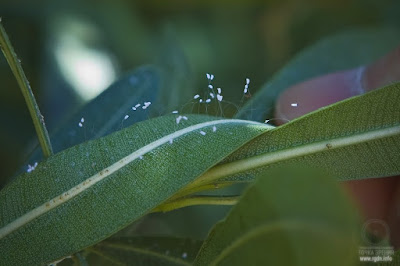༄༅། ། རྭ་ག་ཨ་སྱས་སྒྲིགས་པའི་མ་མོའི་འཁྲུགས་སྐོང་རྒྱུན་ཁྱེར་བཞུགས་སོ།།
བྷྱོཿ ལྔ་བརྒྱ་དུས་ཀྱི་ཐ་མ་ལ།
BHYOH! At the end of the five-hundred-year dark age,
གསང་སྔགས་བོན་དུ་གྱེར་བའི་ཚེ།
When the secret mantra has strayed into Pön,
ཕ་ཟེར་བུ་ཡིས་མི་ཉན་དུས།
When children do not listen to their parents' words,
དུས་ངན་ཉེ་བ་འཐབ་པ་དང་།
An evil time, when relatives quarrel,
གོས་ངན་རེ་ཐུལ་གྱོན་པ་དང་།
When people dress sloppily in clothes of rags,
ཟས་ངན་ལྕི་བ་ཟ་བ་དང་།
Eating bad cheap food,
སྡེ་འཁྲུག་ནང་དམེ་བྱེད་པའི་དུས།
When there are family feuds and civil wars:
མ་མོ་ནག་མོ་ཐུགས་ཁྲོས་ནས།
These provoke the black Mamos' wrath.
བུད་མེད་སྣ་ཚོགས་སྟོང་ཁམས་གང་།
These various women fill a thousand realms,
མི་ནད་ཕྱུགས་ནད་སྣ་ཚོགས་གཏོང་།
Sending sickness upon man and beasts.
མཁའ་ལ་ནད་སྤྲིན་སྔོ་དམར་འཁྲིགས།
The sky is thick with purple clouds of sickness.
དུས་ཀྱིས་འཁྲུགས་པ་སློང་བྱེད་མ།
They incite cosmic warfare.
མཚོན་གྱི་བསྐལ་པས་འཇིགས་བྱེད་མ།
They destroy by causing the age of weaponry.
གློ་བུར་མི་ལ་ལྷོག་རྒོད་འབེབས།
Suddenly, they strike men with fatal ulcerous sores.
ཐོག་སེར་འབེབས་པའི་སྙིང་མོ་ཆེ།
Completely daring, they bring down hail and
thunderbolts.
ས་བདག་ཀླུ་གཉན་ཁྱོད་ཀྱི་འབངས།
Earth lords, nāgas, and nyens are your subjects.
ལྷ་སྲིན་སྡེ་བརྒྱད་ཁྱོད་ཀྱི་འཁོར།
The eight classes-devas, rākshasas, and so on-are
your retinue.
ཁྱོད་ཀྱིས་མི་འདུལ་གང་ཡང་མེད།
There is nothing that you cannot subjugate.
ནད་ཀྱང་མ་མོ་ཁྱོད་ཀྱི་ནད།
Whatever sickness there is comes from you, Mamos;
རིམས་ཀྱང་མ་མོ་ཁྱོད་ཀྱི་རིམས།
Whatever plague there is comes from you, Mamos;
ཁྲག་ཀྱང་མ་མོ་ཁྱོད་ཀྱི་ཁྲག།
Whatever blood there is comes from you, Mamos:
སྤྱི་བདུད་ནད་ཀྱི་ཁ་ལོ་བསྒྱུར།
Please change the course of evil and sickness
བསྐང་ངོ་ཁྱོད་ཀྱི་ཐུགས་དམ་བསྐང་།
We make this offering to you may be appeased
དམ་རྫས་བདུད་རྩིའི་གཏོར་མ་དང་།
By the samaya substances, of torma, amrita.
རྟེན་རྫས་སྒྲུབ་རྫས་སྐོང་རྫས་ཀྱིས།
And the offerings of representations, appeasements, and
practice substances,
འཁྲུགས་པའི་མ་མོའི་ཐུགས་དམ་བསྐང་།
May the turmoil of the mamos be pacified
ཐུགས་དམ་བསྐང་ངོ་ས་མ་ཡ།
Be appeased! SAMAYAL Å
ཐུགས་དམ་བསྐངས་བའི་བྱིན་རླབས་ཀྱིས།
Through the blessings of appeasing you.
རྣལ་འབྱོར་བདག་ཅག་འཁོར་བཅས་ཀྱི།
For us yogins and our disciples
ནད་ཁ་ཆོད་ལ་རིམས་ཁ་བསྒྱུར།
May sickness cease and plague be averted.
ཁྲམ་ཁ་ཕྱིས་ལ་ཤྭ་རྡེལ་སྤོས།
Erase us from your chart of doom: put away your dice
ནད་གདོན་བར་ཆད་བསྒྱུར་དུ་གསོལ།
Please avert sickness, dons, and obstacles
མོ་ངན་མཚན་རྩུབ་བསྒྱུར་དུ་གསོལ།
Please avert evil prophecies and bad omens.
ཕོ་བདུད་དལ་ཁ་གཡས་སུ་བསྒྱུར།
May the misfortunes of the he-māras be banished to
the right:
མོ་བདུད་དལ་ཁ་གཡོན་དུ་བསྒྱུར།
May the misfortunes of the she-märas be banished to
the left:
སྤྱི་བདུད་དལ་ཁ་མཁའ་ལ་བསྒྱུར།
May the misfortunes of all märas be banished into
space.
བཟློག་བསྒྱུར་ཆེན་མོའི་དུས་ལ་བབ།
Now is the time of great exorcism.
དུས་ལ་བབ་པོ་ས་མ་ཡ།
Now is the time-SAMAYA!
ཐོག་མེད་དུས་ནས་མ་རིག་དབང་གྱུར་པས།
Please perform the activities we request of you.
བཅོལ་བའི་འཕྲིན་ལས་འགྲུབ་པར་མཛོད།
Overcome by ignorance from beginning less time,
མ་ཤེས་སྒྲིབ་པའི་ལེ་ལོའི་དབང་གིས་ནི།
Clouded by stupidity due to laziness,
ཐམས་ཅད་མཁྱེན་པའི་ལམ་ལས་འགལ་བ་རྣམས།
However we have strayed from the path of omniscience,
སྤྲུལ་པ་མཁའ་འགྲོའི་ཚོགས་ལ་བཟོད་པར་གསོལ།
May the hosts of emanation däkinis forgive us.
ཨོཾ་ས་མ་ཡ། ཨཱ:ས་མ་ཡ། ཧཱུཾ་ས་མ་ཡ། ཏྲག་རཀྴ་ཁ་མུན་ཏྲེ་ཨེ་ཀ་ཛ་ཊི་སྙིང་ཁ་རཀྨོ་བྷྱོ་ཛ:
OM SAMAYA/AH SAMAYA/HÜM SAMAYA/ TRAG RAKSHA KHAMUNDRA / EKAJATI
NYINGKHARAGMO BHYO JAH/
ཨོཾ་བཛྲ་སཏྭ་ས་མ་ཡ༔ མ་ནུ་པཱ་ལ་ཡ༔ བཛྲ་སཏྭ་ཏྭེ་ནོ་པ་ཏིཥྛ་དྲྀ་ཌྷོ་མེ་བྷ་ཝ༔ སུ་ཏོ་ཥྱོ་མེ་བྷ་ཝ༔ སུ་པོ་ཥྱོ་མེ་བྷ་ཝ༔ཨ་ནུ་རཀྟོ་མེ་བྷ་ཝ༔ སརྦ་སིདྡྷི་མྨེ་པྲ་ཡཙྪ༔ སརྦ་ཀརྨ་སུ་ཙ་མེ༔ ཙིཏྟཾ་ཤྲེ་ཡཾཿ ཀུ་རུ་ཧཱུྂ༔ ཧ་ཧ་ཧ་ཧ་ཧོཿ བྷ་ག་ཝཱན༔ སརྦ་ཏ་ཐཱ་ག་ཏ་བཛྲ་མཱ་མེ་མུཉྩ་བཛྲཱི་བྷ་ཝ་མ་ཧཱ་ས་མ་ཡ་སཏྭ་ཨཱཿ
om benza sato samaya | manupalaya | benza sato tenopa tishta dridho mé
bhava | sutokhayo mé bhava | supokhayo mé bhava | anurakto mé bhava | sarva
siddhi mé prayaccha | sarva karma su tsa mé | tsittam shreyang | kuru hung | ha
ha ha ha ho | bhagavan | sarva tatagata benza ma mé muntsa benzi bhava maha
samaya sato ah
ལག་གཡས་འཛུབ་མོ་སྲིན་ལག་གཉིས་མཐིལ་དུ་བཀུག་མཐེ་བོང་གུང་མོ་མཐེའུ་ཆུབ་གསུམ་བསྒྲེངས་ཏེ་ཏྲི་ཤུལ་གྱི་རྒས།
After that, do the trident Mudra by bending the index and
ring fingers of the right hand against the palm as you stretch your thumb,
middle finger, and little finger and recite:
ཧཱུྃ་ཕཊ་མ་ཧཱ་ངྷེ་ཝཱི་ཀཱ་ལི་དུཥྚཾ་ཏ་ཀ་ཧ་ན་ད་ཧ་རུ་ལུ་བནྡྷ་པ་ཙ་ར་ན་ཧཱུྃ་ཕཊ།
Hung phat maha
dévi kali dushtantaka hana daha rulu bandha patsa rana hung phat
ཅེས་པས་མཚན་ངན་བཟློག
So push back any bad omen.
ལག་གཉིས་སོར་མོ་བཅུང་རྩེ་མོ་ཅུང་ཙམ་བདུས་ནས་ཁོང་བཟླུམ་པོར་བདུད་རྩི་བུམ་པའི་ཕྱག་རྒྱ་བཅས་ལ།
Then forming the Mudra of
the vase of nectar by bringing the tips of the ten fingers of the two hands
together and imagining a vase of nectar coiled in spherical space hollow in our
hands, recite
ཨོཾ་བཛྲ་དྷཱ་ཀི་ནི་དྷེ་ཝཱི་མ་ཧཱ་ཀཱ་ལི་རེ་མ་ཏཱི་ཀཱ་ཡ་ཝཱཀ་ཙིཏྟ་སརྦ་སིདྡྷི་ས་མ་ཡ་ཕ་ལ་ཨ་བེ་ཤ་ཡ་ཨཱ:༁ྂ།
Om benza dakini dhévi mahakali rémati kaya waka tsitta sarwa
siddhi samaya pha la abéshaya ah am
ཞེས་ས་རྭ་ག་ཨ་སྱས། དགེའོ།། དགེའོ།། དགེའོ།། །།
This was composed by Raga
Assya, Vertu, Vertu, Vertu.
Below is another short prayer:
Pacifying the Turmoil of the Mamo:s
This
short supplication is normally done after reciting the Seven-Line Supplication
to Padmasambhava and then Vajrakilaya practice, although it could also be done
without the Vajrakilaya too.
འཁྲུགས་སྐོང་བསྡུས་པ།
PACIFYING THE
TURMOIL OF THE MAMOS
A concise liturgy by Shechen Gyaltsab
སྣང་སྲིད་མ་མོ་མཁའ་འགྲོ་ཚོགས་རྣམས་ལ། །
nangsi mamo
khandro tsok nam la
Mamos and Dakinis of all that appears and exists,
བདེ་སྟོང་ཟག་མེད་མཆོད་གཏོར་འདི་འབུལ་བས། །
detong zakmé
chötor di bulwé
I offer you this torma of inexhaustible bliss and emptiness –
ཕྱི་ནང་མ་མོ་འཁྲུགས་པའི་ཉེས་ཀུན་ཞི། །
chinang mamo
trukpé nyé kün shyi
May all the troubles that infuriate the inner and outer Mamos be pacified
ལྷན་སྐྱེས་བདེ་བ་ཆེན་པོའི་དངོས་གྲུབ་སྩོལ། །
lhenkyé dewa
chenpö ngödrub tsol
And the accomplishment of great spontaneous bliss bestowed!
སརྦ་ཌཱ་ཀ་ཌཱ་ཀི་ནཱི་ས་པ་རི་ཝཱ་ར་མ་ཧཱ་བྷ་ལིཾ་ཏ་ཁཱ་ཧི།
Sarwa Daka Dakini
Sapariwara Maha Balingta KhaHe
ཨོཾ་བཛྲ་སཏྭ་ཨཱཿ
Om Vajrasattva Ah
ཞེས་པའང་བཟང་ལུང་པདྨ་ལྷ་རྩེར་དགོས་གལ་བྱུང་ནས་ལྕགས་བྱ་ཟླ་ཚེས་༢༨ལ་སྔགས་བཙུན་པདྨ་དགྱེས་པས་གང་ཤར་བཅོས་མེད་དུ་བྲིས་པ་དགེ།
Seeing
there was a need for such a liturgy, the mantrika who delights Padmasambhava,
[Shechen Gyaltsab, Gyurme Pema Namgyal] composed this at the delightful Pema
Lhatse in Shang Zabbu Lung, Tsang Province, on the twenty-eighth day of the
iron-bird month.
















